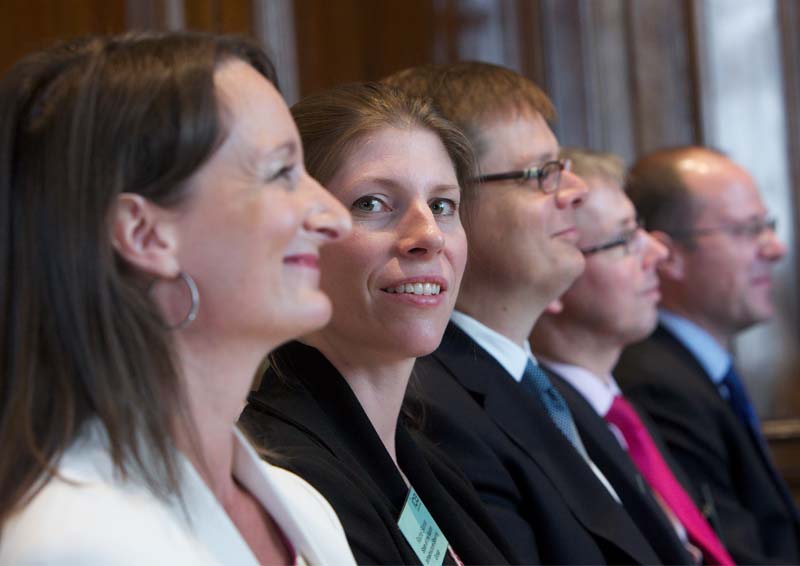Diversity in the construction industry
Contents |
[edit] Introduction
Why is diversity so important? How do we create a more diverse workforce? And how do we ensure that more people have the chance to contribute?
These were some of the questions posed at a June 2015 ICE event chaired by Professor Denise Bower of Leeds University.
Denise opened the event by outlining ICE’s commitment to “take a holistic view of diversity, which addresses fair treatment, inclusion and respect for all members.” ICE’s Capacity Building Panel, which Denise chairs, has its own objective “to provide a framework that supports members to shape their future through real and relevant lifelong learning”.
The keynote speaker, Graham Dalton (Chief Executive, Highways England) explored three key aspects of diversity within civil engineering:
[edit] Why bother?
The argument is simple. To attract enough high calibre engineers to support the next ten years of major infrastructure investment, we must engage the entire talent pool. We can’t afford to exclude at least 50% of potential candidates.
We also have a duty to society, to bring jobs and training to the communities that build and use our infrastructure.
[edit] What do we mean by diversity?
The industry is facing a number of challenges, as set out in Construction 2025. If we’re to come up with innovative solutions for these challenges, we need more than gender and ethnicity diversity. We need diversity of outlook, values, experience and behaviours.
[edit] Leadership
Industry leaders need to make a real effort to encourage this kind of diversity. They need to admit that they might not have all the ideas. They need to listen, note, challenge and take on the best ideas from their staff.
We still face the challenge of making senior jobs more attractive, with the long hours and travel involved. How can we make these roles more compatible with a work/life balance?
[edit] Experiences within industry
Three panellists presented their observations and experiences of diversity within civil engineering.
Katie Morell spoke of Turner and Townsend’s diversity committee and regional working groups, which aim to attract and retain women in the industry. “Attraction” initiatives include a STEM ambassador programme and review of graduate intake. “Retention” measures ensure all events have balanced panels and that flexibility and equality policies are widely used and understood.
A women’s network has also been established at Turner & Townsend – Katie herself is the vice president of the women in transport network.
Katie commented: “People will stay in the industry as long as they don’t get a better offer. We therefore need to create roles that are inviting, interesting and fun.”
Atkins’ Lila Tachtsi praised the “mechanical” things the industry is doing, such as making sure women are in place on panels and boards. While general progress has been positive, the picture is not so good at senior level.
Lila highlighted that Atkins has a Women’s Leadership Council, composed of senior female employees, which aims to challenge the status quo and spot opportunities for women.
Lila also approved of the word “fun”: “I wouldn’t want to work in an all-female environment, so why should others want to work in an all-male environment? It’s more fun to be in a diverse group”.
MPA’s Manon Bradley then emphasised the message that “diversity makes a difference.” A more diverse organisation has better decision making, creativity and innovation – meaning company value goes up.
Manon spoke of the social impact of segregation: “People like to be surrounded by others like them, so to make a change we need to speak to people who are ‘outside the tent.’” Those who attended this event, or are reading this blog, are already engaged in the topic – how do we involve those that aren’t?
Manon also approached the issue of long hours, noting the need for home support in order to succeed professionally. Any person with a family will need help from their spouse, partner, family or hired childcare.
The event’s Q&A session also raised a number of important points:
- The need to coordinate activity around returning to work
- Diversity promotion can be seen as competitive amongst organisations – it should be collaborative and supportive
- Unconscious bias needs to be understood and addressed
- People need to be able to convert to engineering at all stages of their career
- You sometimes need to ”drop people in it” to drive the change that’s needed
[edit] Conclusions
Our event witnessed a number of positive stories, but it’s clear there’s still a long way to go.
The mechanics are there, the opportunities are there, but what we still need is the cultural shift to reap the benefits of diverse organisations.
This article originally appeared as Diversity leads to better decision making, published by the Institution of Civil Engineers on 15 June 2015. It was written by Rob Curd.
--The Institution of Civil Engineers
[edit] Additional notes
According the the Construction Sector Deal, published by the government in July 2018, 86% of construction workers are male, and 94% are white.
[edit] Related articles on Designing Buildings
- Age diversity for social cohesion.
- Boardroom to building site skills gap survey.
- Building Site to Boardroom (BS2B).
- Celebrating women in engineering.
- CIAT celebrates Pride 2020.
- CIC Roadmap for Change.
- Code of conduct.
- Construction 2025.
- Corporate social responsibility in construction.
- Diversity and inclusion in the construction industry.
- Diversity in regeneration.
- Diversity in the built environment sector.
- Eight ways to win the fight for talent in construction.
- Five ways mentoring can benefit a career.
- Flexible working in engineering services.
- Gender pay gap in construction.
- Gender stereotypes examined in Unlimited Potential report.
- Government Construction Strategy.
- Inclusivity in engineering.
- Institution of Civil Engineers.
- International Women in Engineering Day 2018.
- International Women in Engineering Day 2020.
- Interview with Carol Lynch, CYT.
- Investors In People award CIOB silver accreditation.
- ISO 30415.
- Making cities more gender inclusive.
- National Infrastructure Plan for Skills.
- Perkins review.
- Protected characteristics.
- Recruiting and retaining talent in the construction industry.
- Skills shortage.
- Skills to build.
- Sustainability through diversity and multi-culturalism.
- Tackling the construction skills shortage.
- The art of engineering is building for them, her and him.
- The Retention of Women in the UK Construction Industry.
- To attract the right talent, offering flexibility and work-life balance will be essential.
- Women's Engineering Society.








Comments
I'm researching about training on this topic for the business I work for right now, and the more I read the more it is making me want to make sure I find the right training programme! Looking for recommendations on where I can get Diversity and Equality training, currently looking at Keystone Training (http://www.keystonetrainingltd.co.uk/sectors/construction-and-site-safety-training-courses/), has anyone had experience with them before? If so could you email me [email protected]. Thanks!